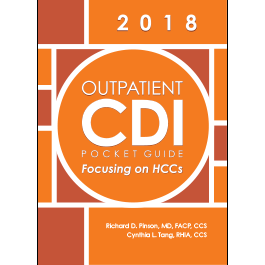Tip: Coding and physician education surrounding HCC capture

HCC capture? Take a look
at the Outpatient CDI
Pocket Guide!
Although Hierarchical Condition Categories (HCC) are not new, addressing risk-adjustment methodologies is becoming more frequent in both the acute and primary settings.
HCCs represent a prospective approach to paying providers or health plans for patients’ care, explains Rose T. Dunn, MBA, RHIA, CPA, FACHE, FHFMA, chief operating officer of First Class Solutions, Inc. in Maryland Heights, Missouri.
The most notable HCC model is CMS’ model for Medicare Advantage (MA), which reimburses MA plans based on the health of their members and is also used for Medicare Accountable Care Organizations (ACO). But there are other models as well, including the HHS-HCC model for Affordable Care Act beneficiaries, which uses a concurrent method to determine reimbursement.
Consider coding specificity
HCC payment is often driven by the number of conditions that the provider monitors, evaluates, assesses, or treats (MEAT).
“Chronic conditions are especially important to MEAT and, therefore, code and claim” accuracy, says Dunn, a member of the advisory board for Health Information Management (HIM) Briefings.
Codes submitted by both hospital and physician office contribute to the HCCs that patients accumulate during the year. Reimbursement for the patient’s accumulated HCCs is based on the risk adjustment factor (RAF) and the conversion factor for the year, otherwise known as the denominator, says Dunn.
Coding specificity is a major part of HCCs because less than 10,000 ICD-10 codes qualify for the 79 HCCs, says Dunn, in a many-to-one system that’s not unlike MS-DRGs. But specificity also heightens the need for outpatient clinical documentation improvement (CDI).
“This serves as an ideal opportunity for coding professionals to take on this concurrent role in physician practices,” says Dunn. “Outpatient CDI should occur while the physician has the patient’s current status fresh in mind. Unlike inpatient CDI, the review of the record should take place on the same day rather than waiting until the next business day.”
Educate physicians, staff
The coding professional’s knowledge of coding requirements is especially important when educating scribes who may work in the practice. The scribe can help capture some of the specificity—in real time—when he or she is with the physician and the patient, Dunn notes.
Education is also important for physicians and the entire staff, says Dawn Diven, BSN, RN, CCDS, CDIP, a CDI specialist at West Virginia University Medicine. “You have to educate staff on what HCCs are and how they impact the patient’s chart,” she says.
Physicians need to understand that the purpose is not to upcode or capture as many as HCCs as possible, Diven says. It’s about accuracy. Sometimes accuracy may mean less reimbursement, she notes. Other times it may mean capturing some patient safety indicators on the inpatient side.
“We make sure that in CDI everything is about accuracy; there is no pressure to move a DRG to make more money [here],” she says. “If you focus on the chart, why they are here, and what is exactly going on, all the MCCs, CCs, HCCs, and reimbursement will take care of themselves” regardless of whether that patient gets treated in the hospital or the physician practice.
Editor’s note: This article originally appeared in Revenue Cycle Advisor.
